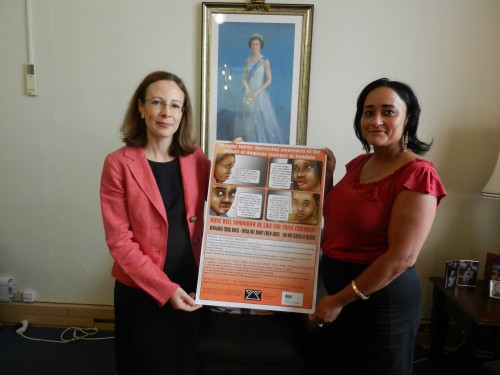30th November 2012 Windhoek, Namibia
Tackling sexual violence in Namibia

My day started early yesterday with a breakfast appearance on national TV’s Good Morning Namibia to discuss violence against women and how to tackle it.
I was joined by Rachel Coomer from Namibia’s Legal Assistance Centre (LAC), a local legal NGO, which is helping to spearhead the current ‘16 days of activism’ in Namibia running from 25 November – the International Day for the Elimination of Violence Against Women – to 10 December – International Human Rights Day.
The 16 day period has been highlighted to symbolically link violence against women and human rights, and to emphasise that such violence is a violation of human rights.
Sadly, rape is still widely used across the world as a tactic of war to humiliate, dominate, instil fear and forcibly relocate communities and ethnic groups.
British Foreign Secretary William Hague used this year’s International Day for the Elimination of Violence Against Women to call for a shattering of the culture of impunity for those who use rape and sexual violence as a weapon and to shift the balance of shame away from survivors to the perpetrators of such crimes.
He promised that preventing sexual violence would be a major theme of the UK’s G8 Presidency in 2013.

Sadly, although peaceful Namibia is now free of conflict, it is not yet free from high levels of sexual violence and domestic abuse.
Rachel presented some really shocking statistics to viewers on the prevalence of domestic violence and rape in this vast country with a small population of 2.1 million:
- 1,085 cases of rape reported in 2011 = nearly 3 per day
- 97% of rape survivors are women in 2011
- 67% of the cases involve a spouse, intimate partner, family member or acquaintance; a clear case of conflict in the home
- More people in Namibia apply for a protection order each year than die in road accidents
- 9 out of 10 victims of domestic violence are women
- 2 out of every 100 victims of domestic violence is a pregnant woman
- Four out of five applications for a protection order are based on physical abuse
- More than 1 out of 5 victims of domestic violence said that their children had been harmed or threatened by the abuser.
- For every victim of domestic violence, six other people are affected. Four are children
This was a real eye opener for me and helped put the issue into a local context. The LAC is working hard to raise awareness of the problem and educate people on what recourse they can take and what support is available via their Seeking Safety campaign.
We both used the programme to urge Namibians to stand up against these crimes to help build a stronger society in Namibia and improve social cohesion.

Later in the day, I joined another colleague from LAC, Yolande Engelbrecht, to launch a new UK-sponsored poster on child abuse as part of the Seeking Safety campaign, to increase awareness of the impact of this type of domestic violence in Namibia.
The poster describes what constitutes child abuse and gives advice on what a child should do if they are being abused. Do keep an eye out for the posters over the coming weeks and get in touch with LAC if you would like to receive some copies to display in your organisations.
The more people we can reach and help with such campaigns the better.
My Niece and Nephew paid the ultimate price of domestic abuse: their father killed them then took his own life. They were just 4 and 3 respectively. The ripples of violence last forever and affect many many more others.
The more we can talk about issues affecting us, the sooner we can eradicate the “need” to resort to violence. It’s our collective global problem.